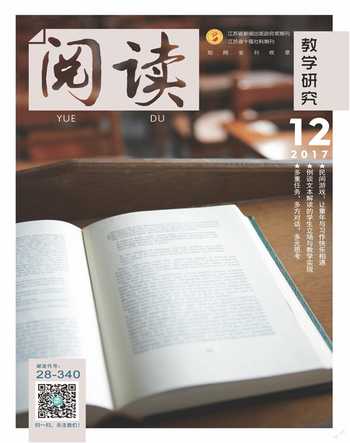“真学”课堂下解读情境教学法
姜琴琴
【摘要】 “真学”课堂要求教师立足于学生原有认知,在尊重学生认知规律和教学活动规律的基础上,积极创设民主、平等、有趣的学习环境,营造师生间自然吸引、彼此感动的和谐氛围。在“真学”课堂下,教师在语篇教学中如何有效诠释情境教学法呢?
【关键词】 “真学”课堂 情境教学 同题异构
近期,在笔者参加的一次教研活动上,教师采用同题异构的方式对译林版《英语》4B Unit 6 Whose dress is this?的Story time进行了教学设计和展示(以下简称A、B教师),诠释了“真学”课堂下情境教学在语篇教学中的有效运用。
一、 灵活导入情境,激发语言习得
俗话说“良好的开始是成功的一半”,“真学”课堂要求教师立足于学生原有认知,在尊重学生认知规律和教学活动规律的基础上,积极创设民主、平等、有趣的学习环境。两位教师根据“真学”课堂的要求采取不同的情境导入,为文本语言的习得铺垫基础。以下是两位教师的导入设计:
A教师
T: Boys and girls, are you happy today? Lets say a rhyme Nice clothes, OK?
T: Its a nice rhyme, right?There are four kinds of clothes in the rhyme. What are they?
T: Today I take more clothes for you. Look, is this a skirt?No, its a dress. (老师贴图片新授指读,并把dress写在黑板上)
B教师
Look and Say (出现文本情境:Fancy dress party)
T: First lets enjoy some pictures about fancy dress party. Do you like it? Where are they?
S: Theyre at the party.
T: What clothes should we prepare for the party? Our old friends Helen, Mike, Su Yang and Su Hai are at the party too.
【分析】 A教师以含有旧知内容的儿歌情境导入,节奏欢快,朗朗上口,不仅帮助学生复习了已学过的衣服类单词,而且为新知的学习铺垫了基础,自然引出本节课将要学习的新词汇,为学生语言的习得渲染了浓厚的氛围。B教师带领学生随着舒缓的音乐走进文本主题情境Fancy dress party,先让学生感受浓烈的party氛围,运用各种图片情境直接进入新内容的学习,引人入胜的教学情境,使学生很快进入了学习状态。
二、 合理运用情境,夯实语言技能
新授环节是一节英语课堂的主轴,决定了学生对语言新知的第一印象与感知。“真学”课堂中,课堂教学的一切行为都应该服从、服务于学生的“学”,教师要努力为学生的“学”营造氛围、提供空间、搭建平台并适时指导,为学生的“学”提质增值。两位教师根据不同的教学设计运用了不同的情境,化抽象为具体,让学生在愉悦真实的氛围中习得新知。以下是两位教师的新授环节:
A教师
1. 参加聚会前课文
T: Just now we talked about the clothes. Our old friends Su Hai and Su Yang are talking about clothes too. What clothes do they talk about?And where will they go? Lets enjoy the cartoon and think.
T: And how do they talk about their dress and trousers?Please read with your partner and answer.
2. 参加聚会时课文
T: We know Su Hai and Su Yang have already dressed up. And theyre at the party now. Who is at the party?What clothes do they wear?Lets watch the cartoon and think.
T: Now we know Helen wears a blue dress. Whose dress is this?
B教师
Watch and Tick
T: What clothes do Su Hai and Su Yang prepare?(教授單词)
Listen and Choose
T: They prepare many clothes. What do they think of the clothes?Lets listen to the story and choose the adjective words. (学习too/so)
Try to Ask
T: Their clothes are so strange. I have a question “Whose ... is this/that?” Can you ask a question?(学生用Whose ... is/are ... ?提问)
Read and Match
自读课文将衣服与对应人物连线。
【分析】 A教师分别用课件呈现文本聚会前情境与聚会时情境,在不同的情境中依次解决词汇与功能句型,词不离句,句不离境,形象而直观地突破了教学难点,突出了英语教学以听、说、读为主的能力培养。B教师通过呈现文本动画,设置相关问题,在文本整体情境中突破教学重点,于整体情境中凸显细节,夯实学生的语言技能。
三、 巧妙结合情境,拓展语言输出
求真务实的语言实践操练是一节英语课堂的点睛之笔,切合实际的语境操练能最大程度地激发学生的语言输出。“真学”课堂,要求把课堂成为学生学的乐园,而不再是教的乐园,每堂课必须让学生进行小组合作学习解决相关问题。让我们一起来看看这两位老师的语境操练设计。
A教师
T:(拿出衣服实物)Whose are they?Can you guess?
T: Lets read after cartoon sentence by sentence, try to imitate.
T: Stand up, lets read in roles together.
T: Now please act in your group.
B教师
Guess and Talk
T: Just now we talked about the girls clothes. Can you talk about Mikes hat and try to make a dialogue. (同桌两人想象一下,自己编一段对话)
Read and Imitate
T: Open your books at Page 38-39, pay attention to tone and pronunciation!
Imagine and Act
【分析】 A教师结合班级实际情境,让学生在自己熟悉的语用环境中猜测,贴近学生的实际生活,学生比较感兴趣,为语言的输出提供了更大的动力。B教师始终不离文本情境,在充分谈论了Su Hai和Helen的着装后,让学生发挥自身想象力探讨Mike的着装,既不需要大费周折地再次设置情境,又能让学生充分体会和理解文本情境,最大限度地发挥了文本情境的作用。
四、 升华主题情境,综合语用技能
学生学习语言的目的就是交际。为了帮助学生将所学知识举一反三并灵活运用到生活中,达到学习目的,两位教师都在文本情境的基础上进行升华,培养学生的语言综合运用能力。
A教师
T: Su Hai and Su Yang go to the party happily. And I also want to go to the party, but I dont have any beautiful clothes, so lets go to the clothes shop to buy, OK?
T: Now we all can go to the party. Lets go!
B教师
Join the party
舞会上你遇到了好朋友,向他们秀一秀你滑稽或漂亮的衣服。
【分析】 两位教师的拓展情境略有相似,A教师设置了自己買衣服参加聚会的情境,将新旧知识相互融合,达到了学以致用的目的,培养了学生的语言综合运用能力。B教师则再次围绕文本情境,将学生置于情境中,由文本语言输入转为学生的语言输出,符合语言的习得规律。
捷克教育家夸美纽斯曾说:“一切知识都是从感官开始的。”情境教学法能使学生身临其境,给学生展示鲜明具体的形象,激发学生的学习兴趣。英语作为学生的第二语言习得,更需要让学生在情境中体会和感悟。如何在英语“真学”课堂中恰当、合理、巧妙地运用情境,促进学生进入“真”的学习状态,值得我们继续研究。
(作者单位:江苏省如东县掘港小学)

